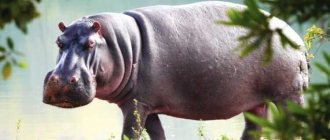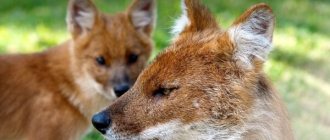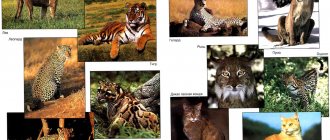The hippopotamus, or hippopotamus, is an artiodactyl mammal of the “chordate” type. It belongs to the suborder "Pigiformes", the family "Hippopotamidae", the genus "Hippopotamus". Large and extremely strong, it is perhaps the largest animal on the planet, slightly inferior in height and weight only to the elephant and white rhinoceros. Hippos live exclusively on the African continent, but traces of their presence have also been found in Europe. In the past, there were several species of these animals on the planet, but changing weather conditions, as well as their mass extermination by humans, led to the fact that only two species can be seen in Africa - the common hippopotamus and the pygmy hippopotamus.
Origin of the hippopotamus
Until 1997, scientists believed that the hippopotamus was one of the relatives of the common domestic pig, to which it belongs. This assumption was based on the external appearance of the animal, the physiological characteristics of the structure of the skeleton and internal organs. An in-depth study made it possible to refute this statement. Research 10 years ago showed that hippos are close relatives of whales. Scientists use the following facts as evidence:
- hippopotamuses are inhabitants of freshwater, some species of ancient whales also lived exclusively in freshwater bodies;
- whales give birth and feed their young in the water, hippopotamuses do the same;
- whales and hippopotamuses have no hair, with the exception of rare bristles on the head and tail;
- whales communicate underwater using special sounds, hippos growl and thus communicate with each other;
- The testes of the whale and the male hippopotamus are located inside the body.
The ancestor of the pygmy mini hippopotamus appeared about 54 million years ago. The animal lived in the thicket of the tropical forest and preferred to live alone. About 2.5 million years ago, common hippopotamuses appeared - gigantic and extremely aggressive creatures that quickly spread across the planet. In ancient times, at least 4 different species of representatives of the genus Hippopotamus lived on the African continent, but gradually they all became extinct. As a result of studying animals, specialists arose other questions, such as: is a hippopotamus artiodactyl or not, what did ancient hippopotamuses eat in nature, how long did hippopotamuses live?
Hippopotamus or hippopotamus?
Are hippopotamus and hippopotamus the same animal, or are they two different animals? The question of how a hippopotamus and a hippopotamus differ is of concern to many generations of people, and the answer to it should be sought, first of all, in geographical and political disunity.
Thus, from Greek the word “hippopotamus” is translated as “river horse.” It was the Greeks who first used this term in relation to the harsh inhabitants of Africa.
At the same time, in the Hebrew language there is the word “hippopotamus”, used in the plural and interpreted as “animal”. This word first appeared in Russian around the second half of the 18th century.
Europeans discovered the expanses of the African continent a little earlier and named the animal they saw - hippopotamus; representatives of the Slavic world who arrived in Africa did not know that a name had already been invented for the creature they saw. The lack of necessary information led to the appearance of two names for the same animal. Moreover, the word “hippopotamus” is used mainly by residents living in the CIS countries, while the term “hippopotamus” is used throughout the rest of the world. Thus, the main thing that distinguishes a hippopotamus from a hippopotamus is the spelling of the word itself; there is no difference between a hippopotamus and a hippopotamus.
Natural enemies
Since this animal has the same mass as an elephant, it is not suitable as prey for other predators. Currently, only lions and Nile crocodiles pose a threat to hippopotamuses. But they can only attack and kill young animals or females, because the size of an adult male also determines his strength. Long fangs, which, although designed for tearing vegetation, can tear apart even a large and strong lion without any problems. That is why not a single predator risks attacking adults alone.
The Nile crocodile is the enemy of the hippopotamus
In the wild, only a pack of lions working together can kill an ordinary hippopotamus. And then, if there is a body of water nearby, the giant will easily hide from his ill-wishers. Scientific reports describe several cases when three or four lions decided to surround and attack a hippopotamus, and the hippopotamus, since its territory was nearby - water, rushed there. They followed him, which they almost immediately regretted: the seasoned large mammal, without any problems, began to drown and ram his enemies, so it was not he who had to run, but they, in order to stay alive. From similar cases, a situation is also known when a pair of lions decided to feast on a baby hippopotamus, but a female came to his aid, as a result of which one predator was crushed and the other was drowned in liquid silt.
Crocodiles, by the way, do not always attack their neighbors in their habitat; often, on the contrary, they coexist peacefully with each other. It often happens that the female leaves young individuals in the care of crocodiles, and they protect them from hyenas or lions. Crocodiles can also ride on the backs of adult animals, creating duos of shallow water monsters. However, due to some defect in the brain of one of the mammals, crocodiles or hippos act aggressively towards each other, attacking and eating each other.
There have been reports of alligators attacking adult males and even successfully defeating them, but this is rather an exception, since those individuals were sick or injured. According to people's observations, when the number of crocodiles decreases due to their actions, the number of hippopotamuses in those areas increases sharply. This fact clearly demonstrates that one way or another, the population of one species directly depends on the population of another.
If even a strong lion does not risk attacking an adult, then with cubs things are different - they are eaten without problems not only by kings of animals, but also by leopards and hyenas. According to currently known data, in the first year of life, young animals die due to attacks by natural enemies in 30-50% of cases. In addition, during migration, adults can simply crush babies.
Types of hippos
There are only two species of hippopotamuses left on Earth:
Hippopotamus or common hippopotamus
Hippopotamus or common hippopotamus (Hippopotamus amphibius). A massive animal, reaching 5.5 meters in length and 1.7 meters in height. The huge belly of the hippopotamus rests on short legs, the length of which is so short that when walking the animal touches the ground. Each leg ends with 4 toes with stable hooves, between which there are membranes that allow good swimming and prevent drowning when walking on swampy soils (the structure of the legs of a pygmy hippopotamus is similar).
The skull is rectangular, the ears are small and mobile, the nostrils are wide and stick up, the eyes are small, hidden under thick eyelids, but clearly visible. On both sides of the nostrils there are knob-shaped swellings, characteristic exclusively of males. The mouth opens 150 degrees, while the width of the jaws is at least 0.7 meters.
The hippopotamus has 36 teeth - 6 premolars, 6 molars, 2 canines and 4 incisors. The teeth are covered with yellow enamel.
The canines of males are sickle-shaped with a longitudinal stripe, located on the lower jaw, can reach a length of up to 0.6 meters and weigh up to 3 kilograms. If an animal has lost a paired canine located on the upper jaw, then the lower one can reach 1 meter in length, pierce the lip and make normal eating impossible.
Hippopotamus or dwarf hippopotamus
Hippopotamus or dwarf hippopotamus (Hexaprotodon liberiensis), also known as "mwe-mwe" and "nigbwe". It has an external resemblance to a larger representative of the genus, but is somewhat smaller in size. Poachers know best how much a hippopotamus weighs, thanks to whose actions the animal is on the verge of extinction.
The legs of a mini hippopotamus are longer, the neck is clearly visible, and there is only 1 pair of incisors in the mouth (an ordinary one has two). The animal's back is slightly tilted forward, its nostrils and eyes are practically indistinguishable. Body length – 1.5-1.7 meters, height – 0.8 meters. The protective fluid on the body takes on a pink tint; in most common hippos it is red.
In ancient times, two more species of these animals lived on Earth:
- Hippopotamus antiquus. Lived in Europe over 1 million years ago. Its fossil remains were found on the territory of modern Germany.
- Hexaprotodon harvardi. The remains of this type of hippopotamus date back to 7.5-5.6 million years ago. This animal most closely resembled its modern dwarf descendant.
When studying modern species of hippopotamuses, at least 5 subspecies are distinguished, each of which has its own habitat, but similar external characteristics:
- Hippopotamus amphibius amphibious Linnaeus;
- Hippopotamus kiboko Heller;
- Hippopotamus capensis Desmoulins;
- Hippopotamus tchadensis Schwarz;
- Hippopotamus constrictus Miller.
Genetic differences between the first three subspecies mentioned were identified only in 2005; the existence of the remaining two subspecies is questioned.
Regardless of the type of hippopotamus, all individuals have a small tail, up to 0.54 meters in length. It is round and thick at the base, but becomes flat towards the end. There are small bristles at the end of the tail. Vibrissae cover the animal's wide muzzle and ears, and are present in small quantities on the sides and belly.
The hippopotamus, like the rhinoceros, is considered to be thick-skinned. Its body is covered with a layer of skin 4 centimeters thick.
The color of the back is gray, light brown, the belly, head and ears are pink.
A beginner in understanding the animal world of the planet will hardly be able to find differences between the dwarf and ordinary hippopotamus, but an experienced researcher will definitely say that these animals have little in common. The difference is evident from the habitat to the way the baby is born.
Where do hippos live? Habitat
The habitat of the modern hippopotamus is largely limited, but only 1 million years ago this animal was found in the European part of Eurasia, the Middle East, the islands of Cyprus and Crete, as well as Madagascar (dwarf species) and England. The disappearance of the hippopotamus from the European part of the continent and islands is associated with the onset of the last ice age during the Pleistocene era. Moreover, the animal lived in Palestine until the beginning of the Iron Age, and disappeared from northwestern Africa only in the era of antiquity. Huge herds of hippopotamuses were found in the Nile Delta and Upper Egypt; they finally disappeared only at the beginning of the 19th century.
The common hippopotamus or hippopotamus lives in Africa south of the Sahara Desert. You can meet it in Kenya and Tanzania, Uganda, Zambia, Malawi and Mozambique. The number of hippos in these areas reaches 80 thousand. The animals also live in West Africa; small herds of them remain in Senegal, Guinea-Bissau, Rwanda, Burundi, and Congo. At the same time, not only the animals themselves are under threat of destruction, but also the places where hippos live.
Pygmy hippos also live on the African continent, they are found in Liberia, the Republic of Guinea, Sierra Leone and Ivory Coast.
Both the pygmy hippopotamus and the common hippopotamus live in water. Sometimes they settle where the river flows into the sea, but they do not like salty sea water, although they can swim across the straits in order to get to the islands.
The size of the reservoir and the purity of the water are not important for this animal to feel good; a small mud lake, the banks of which are covered with thick grass, is enough. If the lake dries up, the hippopotamus migrates in search of a new habitat. He does this extremely rarely, but there were still precedents. Long journeys are harmful for the animal; its thick skin needs constant wetting with liquid, the long-term absence of which can lead to the death of the individual.
Structure
In fact, the hippopotamus skeleton has many characteristic features that are not repeated in any other mammal - this is necessary so that the animal does not suffer from its size and weight.
The bones of a hippopotamus are massive and strong, but the vertebrae are considered its strongest parts. The shoulder blades are located almost vertically and form an almost completely even line with the front legs. There are 26 ribs, i.e. 13 pairs
According to the research of the famous German zoologist B. Grzimek, who described the hippopotamus skeleton and the size of its organs, people were able to calculate approximate figures. During the cutting of the corpse of a young mammal, whose weight was about one and a half tons, the following indicators appeared: the weight of the meat separated from all other parts was 520 kg; the bones weighed 280-300 kg, the skin - 48 kilograms, the heart around 8-10, the tongue - 5-6 kg, and the liver 30. According to veterinarians, the intestinal tract reached 60 meters in length, due to which hippos without special problems absorbing huge amounts of fiber. The stomach has three chambers and is considered huge even by artiodactyl standards.
If we talk about absolute size, regardless of the rest of the body, then the brain of this animal is quite large and reaches 900 cubic centimeters. But if you take into account the overall size of the body, then it is incredibly small and makes up only 1/2790 of the part; for comparison, the human brain occupies about 1/40.
Behavioral characteristics of hippos
The character of an animal depends on its species. Thus, the common hippopotamus is one of the most dangerous inhabitants of Africa. He is aggressive, easily irritated, and does not need a reason to get into a fight. Both males and females show aggression. Moreover, it can be directed both at other animals and at humans.
The brain of a hippopotamus is so primitive that it is practically incapable of distinguishing between friends and enemies in its environment, which is why the animals often enter into battle with an opponent superior to them in strength - a rhinoceros and even an elephant. The only value for a male is the territory he occupies, and for females - the young offspring. In order to protect them, animals destroy everything in their path. An angry or frightened animal runs at a speed of 30-40 kilometers per hour, so it is better not to anger the hippopotamus.
The pygmy hippopotamus is less aggressive, both towards its relatives and towards other animals. This inhabitant of Africa is considered not dangerous to humans; he is calm and tries to avoid conflicts.
Security status
Over the past 10 years, the hippo population has decreased by 7-20%. It has been recorded that between 125,000 and 148,000 individuals remain in the 29 countries within its geographic range. Although poaching is illegal, it remains the leading cause of death for these animals. The hippos that inhabit unprotected lands suffer the most from poaching. Habitat loss is another factor in the decline of hippopotamus populations. Hippos depend on freshwater bodies, which makes them vulnerable to droughts, agricultural and industrial production, and rerouting of natural water flows. There are conservation measures for the hippopotamus population aimed at protecting natural habitats. Countries where there is a high population of hippopotamuses have strict regulations prohibiting hunting. The habitats of hippopotamuses, namely national parks, nature reserves, and museum reserves, are carefully protected.
What does a hippopotamus eat?
The hippopotamus is a large animal, so the question of what a hippopotamus eats, what hippopotamuses eat in their natural environment, is more than relevant. The diet includes at least 27 species of plants, most of which grow along the banks of the reservoir. The animal refuses to consume algae and other aquatic plants. Thanks to its powerful jaws, the animal manages to grab grass stems as close to their base as possible. One adult common hippopotamus and hippopotamus consumes up to 70 kilograms of green mass per day. The stomach is as long as possible for such large individuals, allowing it to digest food 2 times faster than an elephant or rhinoceros does. In this regard, the hippopotamus is lucky, since it needs 2-3 times less food to be full.
The pygmy hippopotamus eats exclusively green shoots and fruits, this is all they eat at any time of the year. An ordinary hippopotamus does not disdain carrion and is quite capable of catching and eating a doe or any other smaller animal. The need for meat food is a consequence of a lack of microorganisms and salt.
Population
At the moment, ordinary hippopotamuses are not experiencing any special problems with the population. Their massive size makes it difficult for even poachers to hunt without difficulty. You also need to take into account that even wild territories are, one way or another, under protection, which means it simply won’t be possible to kill an individual of such a gigantic size.
The situation is much worse for pygmy hippos - their numbers are limited and may soon decline to the stage at which they will be classified as an endangered species. This occurs due to the physical weakness of small individuals, which cannot boast of either size or strength. The only thing they have to do in case of an attack is to run, but the bullet will still be faster and after just a couple of shots the animal will fall lifeless. People are trying to compensate for the deficiency by taking under protection more and more areas where dwarfs live, but this still does not bring visible results. If a poacher can be prevented from taking his prey, then he will still be able to kill it, and then hide when he notices something is wrong.
Judging by historical information, unlike bison or elephants, hippos were not subject to mass extermination and the hunt for them was not so fierce.
Hippo lifestyle
The common hippopotamus and hippopotamus are herd animals. The number of individuals in one such herd usually ranges from 30 to 200 heads. Each herd consists of females and males, led by the strongest of them.
The leader defends the right to hegemony in battle with his relatives, including descendants. Battles between males are particularly brutal; the winner can pursue a defeated enemy for many kilometers. Most battles take place in water, so the weaker male has the opportunity to escape by diving into the depths. Regardless of how weak or strong the enemy is, he is still dangerous to the life of the hippopotamus. Males that win a battle often die from their wounds. No one can predict what the outcome of the battle will be.
In nature, pygmy hippos stay apart from their relatives. He prefers to live separately or in pairs; there are no herd instincts, and the animal does not protect its possessions.
As mentioned above, hippos spend almost all their time in the water. They are able to completely submerge to the bottom of a reservoir and remain there without air for 10 minutes. Hippos are mostly herbivores, but their lifestyle has much in common with how predators live. This is manifested, first of all, in the choice of time of day to search for food. As a rule, animals go in search of new pasture at night. This unusual behavior is associated with the daytime heat, due to which the hippopotamus needs to dive into water every 20-30 minutes.
Nutrition
Hippos leave their waters at dusk and move to nearby grassy areas. They prefer to be close to water, however, if there is a lack of food, they can move several kilometers away. Grazing lasts for 4-5 hours every night. Their diet mainly consists of small shoots, grass and reeds. They do not dig up roots or fruit. However, hippos will consume many other types of plants if they are nearby.
The muscular lips, about 50 cm wide, are ideal for pulling grass. Hippos do not use their teeth to chew food; instead, they tear up grass to prevent loss. While their sedentary lifestyle allows for a simple diet, they are known to consume huge amounts of food each evening, 1-1.5% of their body weight (about 40 kg on average). Hippos enter and exit the water in the same place; they return from pastures before dawn. Sometimes, if a hippopotamus has gone too far from water, it will look for a body of water nearby so it can rest before the next nightfall. Some hippos have been spotted eating dead animals near their ponds. However, their stomachs are not designed to digest meat. It is possible that carnivorous behavior is a consequence of disease or malnutrition.
Reproduction of hippopotamuses, care of offspring
Puberty of female common hippopotamuses occurs between 6 and 15 years, males become sexually mature by 6-14 years. Mating games begin in February and continue until the end of August. The offspring are born during the rainy season. Animals ready to mate dive into the water, but try to stay closer to the shore. Pregnancy lasts from 227 to 240 days and does not cause practically any problems to the already overweight female. An animal that senses the approach of childbirth leaves the herd. Childbirth takes place in water, or in high coastal thickets.
A newborn hippopotamus weighs from 30 to 50 kilograms, its body height reaches 0.5 meters, and its height is 1 meter. He is quite independent, gets to his feet 3-4 minutes after birth. If the birth took place in water, then the female pushes the baby onto land so that it does not suffocate. He will learn to swim well and stay under water no earlier than after 2-3 months, but he returns to the herd already on the 10th day after birth. The female takes care of the cub until it reaches 1.5 years of age. Before this, the small hippopotamus stays close to its mother, feeds on milk, which it also consumes when the female is in the water. Hippopotamus milk is extremely nutritious.
The young common hippopotamus is born with 32 baby teeth. At one year of age, these teeth fall out and 36 permanent teeth grow in their place.
The desire of dwarf animals to stay apart makes it almost impossible to study the mating process of hippopotamuses in their natural habitat. Animals become sexually mature by the age of 3-4 years. In a zoo, they form stable monogamous pairs. Mating does not depend on the time of year, the duration of pregnancy is up to 200 days. The female gives birth on the shore, the newborn pygmy hippopotamus weighs only 6 kilograms, quickly gets to its feet, but does not dare to swim and dive for a long period of time. For the first 6-8 months, a baby hippopotamus feeds on milk.
They are created for aquatic life
Hippos have unique skin that needs to be kept moist for most of the day. Staying away from water for too long can lead to dehydration, so hippos try to stay in the water during the daytime. In addition, being under water helps the hippopotamus not to feel the weight of its clumsy body.
Photo: www.isilimelalodge.com
The body of a hippopotamus is well adapted for an aquatic lifestyle. Its eyes are located on the top of its head, so the hippopotamus can submerge most of its body underwater and still see what is happening above the water. A transparent membrane covers and protects his eyes, allowing him to see perfectly in the water. The nostrils are also located at the top of the snout, so the animal can remain underwater, but still breathe and sniff the air. When a hippopotamus dives, its nostrils close to keep water out.
The ears are located high on the head, so the hippopotamus can hear what is happening above the surface of the water while swimming. But what about sounds underwater? This is the job of the hippopotamus's jaw, which conducts sound waves. Thus, a hippopotamus with its jaw down can hear sounds above and below water at the same time!
And one more way the hippopotamus adapts to life in water: the ability to hold its breath for up to five minutes. They are even able to sleep in the water, using a natural reflex that allows them to jump up, catch their breath and sink back to the bottom without waking up.
What threatens hippos?
The main enemy of the hippopotamus is man, who hunts it for meat, bones and skin. For small, weak hippos, the Nile crocodile and lion are also dangerous. An adult male, or a female protecting a cub, can cope even with a flock of lions, provided that the battle takes place not far from water.
Left unattended, the baby hippopotamus is attacked by hyenas, wild dogs and leopards. In the first year of life, from 12 to 50% of the young die, and the threat to them comes not only from predators, but also from their own relatives. In a fit of rage or panic, the herd can trample the baby.
The high mortality rate of hippopotamuses is largely due to the widespread anthrax among them. As a result of another outbreak of the disease that followed in 1987, over 21% of the individuals living along the banks of the Luangwa River (Zambia) died.
Constant exposure to dirty water causes hippos to develop diseases such as brucellosis and salmonellosis. In zoo conditions, animals are threatened by tuberculosis, young animals have inflamed intestines and brains, and various types of fungus infect the body.
How much do hippos weigh?
Females and males under 10 years of age weigh the same. The difference in the weight of hippopotamuses appears after another 2-3 years; it is not significant, therefore it is almost impossible to visually detect the difference between a male and a female based on appearance. The body weight of a hippopotamus is from 185 to 230 kilograms in dwarf species. The average weight of a barrel-shaped body of a hippopotamus is 3-4 tons. Moreover, the animal’s head weighs at least 1 ton and makes up 25% of its body weight. If the question of how much a hippopotamus weighs is of most concern, then for comparison you should imagine a trailer loaded with stones. The weight of the animal is equal to 2 or even 3 such trailers.
Keeping hippos in a zoo
The pygmy and common hippopotamuses live exclusively in freshwater bodies of water; their migration to the coast is a rare phenomenon, in most cases associated with the drying out of the reservoir. No special conditions are required to keep an animal in a zoo; it is enough to provide it with a spacious reservoir and sufficient food. Males and females living in an artificial environment behave less aggressively, which is due to the absence of the need to fight for territory.











